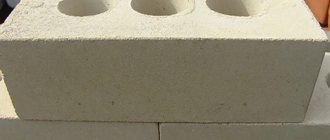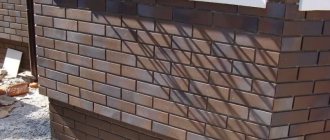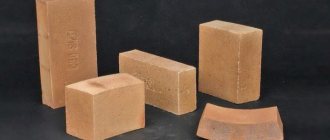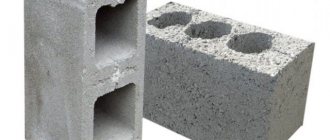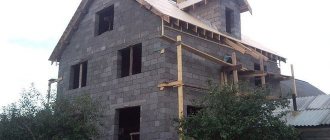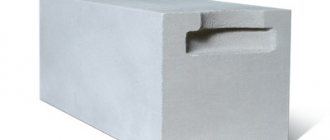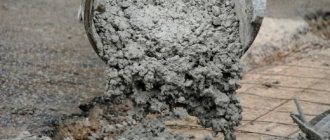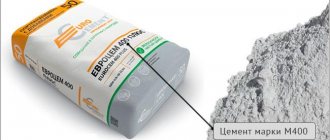White or sand-lime brick is the most common of modern building materials. Houses, garages, hangars and other structures are built from it. It is also effectively used for finishing facades, erecting interior partitions, fences and other structures. Let's look at what this type of brick is, what are its features, pros and cons, technical characteristics, varieties and scope of application.
Laying the wall of a house made of sand-lime brick Source stroychik.ru
Sand-lime brick - description, composition, production
Unlike the usual clay brick, silicate brick contains quartz sand and lime. The first component accounts for approximately 90%, the second – no more than 8%. The raw material used is quartz sand of fine and medium fractions. The lime mass serves as a cohesive structure - like cement in concrete. In addition, several percent of frost-resistant components and dyes are also added to it.
At the same time, in order for the manufactured product to acquire the characteristics specified by building codes (primarily strength), the manufacturing technology includes the following three mandatory sequential stages:
- Preparation of raw materials. Drum mixing of dry components until homogeneous, followed by steam treatment - for slaking airborne lime. Next comes thorough mixing and 10-hour exposure of the mixture.
- Pressing of raw materials. In special molds, the finished mixed mass is compacted under high pressure by a special installation.
Production of sand-lime brick Source stroychik.ru
- Autoclaving and drying. The formed blanks are transferred to special chambers, where under the influence of a pressure of 10 atm, a temperature of 200°C and an atmosphere saturated with water vapor, they acquire the necessary properties within 10-15 hours. After this, they are unloaded into a warehouse.
Therefore, modern sand-lime brick is not just a building block formed in natural conditions (like ceramic bricks), but a more durable material, with properties comparable to concrete.
What is the difference from red brick
Characteristics in comparison with ceramic bricks
A silicate block has very different properties from a clay block. When choosing a material for construction, this difference should be taken into account.
- The strength of silicate is usually higher . At the same time, the weight of the stone is only slightly less than that of clay, so the foundation has to be built the same.
- Frost resistance – clay brick is less porous and absorbs less moisture . Silicate is not suitable for rainy climates or the sea coast. You can also use it, but you will have to make a lot of effort to protect it from moisture.
- The cost of a silicate block is much lower . At the same time, the masonry technology is the same. Construction is becoming cheaper.
- Thermal conductivity coefficient - in this parameter, clay brick is noticeably superior to white brick . In mid-latitudes, walls made of ceramic blocks of the same thickness do not need to be insulated.
Although white brick comes in several colors, red brick looks much more impressive. In addition, silicate absorbs moisture unevenly: stains, stains of absorbed dirt, and efflorescence appear on it. Ceramic retains its attractiveness much longer.
Advantages and disadvantages
The main advantages of white brick include:
- High strength indicators - up to 200 kg/cm².
- Optimal cost.
- Full compatibility with any masonry mortar – from classic mortar to polymer adhesives.
- Heat resistance – up to 6000°C.
- Environmentally friendly - does not contain toxic components, has minimal radioactivity.
- Precise geometry and dimensions, which makes storage lighter and improves aesthetics.
- Good sound insulation properties.
- Frost resistance – from 50 cycles.
- Aesthetics, large selection of color options.
A house built from sand-lime brick Source bel-dom-stroy.ru
However, the material is not without its drawbacks:
- Heavy weight - requires a strong foundation.
- Susceptible to destruction in a damp environment, therefore not suitable for damp, basement and basement areas.
- Insufficient thermal insulation - in cold regions, additional wall insulation is required.
- Destruction during rapid heating - unlike traditional bricks, silicate bricks are not suitable for creating stoves, barbecues, fireboxes, and chimneys.
- Limited decor - only rectangular shapes are available.
- Significant degree of water absorption - up to 8%.
On a note! Despite all the disadvantages, the advantage of sand-lime brick lies primarily in the low cost and good strength of the material, due to which many consumers choose it when building their home.
See also: Catalog of companies that specialize in designing country houses
Well-known manufacturing plants
The top five brick factories in Russia are the following enterprises:
- LLC Kazan Plant of Silicate Wall Materials. This plant operates in Tatarstan. The company manufactures and produces 230 million units of products per year. The main pride of the plant is a modern press from a German manufacturer. It allows us to produce products with clear edges, precise geometric dimensions, good strength and frost resistance. The plant can produce sand-lime bricks of increased size 498x70x249mm, which are well suited for the construction of partitions.
- CJSC Voronezh Construction Materials Plant. The company has a large area of land, which is planned to be used in the future to expand production. The plant produces 144 million units of products per year. Its products are distinguished by highly efficient performance and improved characteristics.
- LLC "Invest-Silikat-Stroyservis". The company operates in the Ural-Siberian region. This is one of the most mature enterprises. He is over 50 years old. The number of products produced per year is 140 million units. To produce bricks, the plant uses its own lime. Sand is obtained using natural washing. The company has a wide range of color shades. This allows the products to be used in a variety of architectural ideas.
- LLC "Silikat" The company is located in the Ulyanovsk region in the Novospassky district. The plant produces construction lime and sand-lime brick. The production capacity of the enterprise is 100 million pieces per year. Silikat LLC has the ability to deliver its products to any region of Russia. The plant workers developed the correct scheme for placing finished products on pallets. Thanks to this, the brick is delivered to the consumer without damage.
- OJSC Lipetsk Plant of Silicate Products. This is the leader in construction production in Russia. Its products are used not only by residents of the Lipetsk region, but also of Tula, Moscow, Tambov and Ryazan. The plant's products have a certificate of conformity and a sanitary certificate. The company is constantly modernizing production. The plant's capacity is 110 million units per year.
Specifications
Digital values of the main technical characteristics of white brick vary within the following limits:
- Density – 1.3-1.9 thousand kg/m³.
- Compressive strength – 25-300 kgf/cm².
- Bending resistance – 8-40 kgf/cm².
- Frost resistance – from F15 to F100 (from 15 to 100 cycles).
Sand-lime brick retains its properties in any cold weather Source kirpich-dvor.ru
- The average thermal conductivity of the hollow modification is 0.66 W/m °C, the solid modification is 0.7 W/m °C. In general – 0.38-0.7 W/m °C.
- Safe heat resistance – 2500С, thermal destruction – from 5000С.
- Sound insulation – 63-65 dB.
In addition, sand-lime brick has good vapor-permeable characteristics. Thanks to this, the indoor microclimate is always kept healthy.
Varieties
Based on their structure, silicate-based bricks come in two varieties:
- Full-bodied.
- Hollow.
Unlike ceramics, in silicate blocks the voids have a strictly cylindrical cross-section and are located symmetrically relative to the center. According to the purpose of use, they are also classified into:
- Privates.
- Facing.
The first ones are intended to form the main masonry of the structure and take on the main load. Upon completion, mandatory external finishing is expected. For this purpose, the facing modification is used. At the same time, the structure of the facial blocks, as a rule, contains pores to reduce weight.
Based on the presence of coloring pigment, the blocks are divided into:
- Standard ones are naturally white.
- Colored - with the addition of the appropriate shade.
Colored sand-lime bricks Source tver-13.ru
Based on their dimensions, they are divided into three modifications:
- Single – 250x120x65 mm.
- One and a half – 250x120x88 mm.
- Double – 250x120x130 mm.
In this case, the dimensions, as well as the weight, are specified by GOST. So the weight of sand-lime brick 250x120x65 solid single is 3.6 kg, one-and-a-half 250x120x88 is 4.9 kg (solid) and 4.3 kg (hollow), double 250x120x130 is 7.7 kg (solid) and 6.7 kg (hollow) ).
Helpful information! The bricks may contain ash or slag with partial or complete replacement of standard components. On sale, such products are called sand-lime or slag-ash-lime varieties of silicate blocks.
Dimensions of bricks according to GOST Source stroy-okey.ru
Dimensions of the silicate block, its main purpose
In terms of characteristics, including size and weight, the material must comply with the requirements of GOST 30108-94 “Construction Materials and Products”. In accordance with this regulatory document, the standard sizes of white sand-lime brick are determined.
The silicate block can be solid, hollow or porous-hollow. Solid brick is used in the construction of external walls of buildings and internal load-bearing partitions; hollow brick can be used for external cladding of a building.
According to their purpose, white silicate stone is divided into two main types:
- Ordinary (used for laying walls, which will then be lined with other materials). It is allowed to have a small number of cracks, chips on the edges, and dullness of the ribs;
- Facial (aka facing). There should be no damage to its surface. Facing bricks can be produced with a smooth or textured surface. There are also unpainted and painted versions of such bricks.
Advice! Before purchasing white sand-lime brick, consider what it will be used for. The material is not suitable for wells and basement structures.
Marking
Bricks of the modification in question available on the building materials markets have mandatory markings. The following three notations are primarily used:
- Durability brand. Denoted by the letter "M". For example, M125 - the higher the digital value, the more durable and reliable the structure will be.
- Frost resistance category. Displayed as "F". For example, F100 means that the material will withstand 100 cycles of freezing and defrosting.
- Thermal conductivity. The higher this indicator, the worse the material retains heat. Therefore, a thicker wall or the use of insulation is required.
Areas of application
The building material of the modification in question is widely used in private construction for the following purposes:
- Construction of permanent walls of houses, garages, utility rooms.
- External finishing of concrete, brick, aerated concrete walls.
- Creation of partitions inside finished structures.
- Formation of fences and enclosures, decorative elements.
Advice! Sand-lime brick is not used for the section of the house wall that is in direct contact with the concrete mass of the foundation, and if it is used in this case, it is only with full protection in the form of multi-layer waterproofing.
Where is it used?
White and red bricks are used to build premises for various purposes. A special feature of the silicate product is its poor moisture resistance, which makes it impossible to use it in buildings with high humidity. This specificity of white brick is even indicated in GOST, and does not imply its use in the construction of basements, wells and other structures of this type. Ceramic products are used for such purposes. A white brick house is built on a red brick foundation. Both products are well suited for cladding rooms and erecting fences. In such cases, red material is purchased from one batch, since the color shade of the products depends on this. Ceramic brick is highly fire-resistant, so it is used to construct stoves, fireplaces and other structures that can be exposed to high temperatures.
Briefly about the main thing
Sand-lime brick is no different in shape and size from its standard ceramic counterpart. However, in terms of composition and production technology, this is a completely different building material. It consists of 90% quartz sand and 10% lime, water, plasticizers and dyes. Among its main advantages are:
- Great strength.
- Frost resistance.
- Low cost.
- Safety.
- Accuracy of shapes and sizes.
- Heat resistance.
- Soundproofing.
- Aesthetics.
The main disadvantages include heavy weight, insufficient thermal insulation, high moisture saturation coefficient and susceptibility to destruction in a humid environment. By structure, bricks are divided into solid and hollow, by purpose - into ordinary and facing, by color - into regular and colored, by size - into single, one-and-a-half and double. The marking indicates the strength grade, frost resistance and thermal conductivity. Bricks are used both for capital construction and for external finishing and creating partitions.
How to set up a production line
The production process using the equipment described above requires significant material costs.
Mandatory manpower will be required. The production process will necessarily require a large area of land, a constructed production building and a warehouse for raw materials and finished products. To produce bricks you will need to spend:
- 19,666,000 rubles – field development. The article includes survey work, purchase of vehicles, construction of roads, purchase of carriages and scaffolding.
- 115,000,000 rubles – construction of the plant. This article includes: construction of structures, buildings; purchase of equipment; construction, installation and research work; other expenses).
- 1,555,000 rubles – working capital.
As can be seen from the estimate, the entire production process revolves around large financial investments. If an entrepreneur does not have such capabilities, then you can purchase a minimum set or start production at home. Under such circumstances, 10 million rubles will be required. Productivity will be about 4 million pieces per year. According to estimates, payback will occur in approximately 2 years.
This video will tell you what a sand-lime brick production line is:
We will tell you about sand-lime brick factories below.
